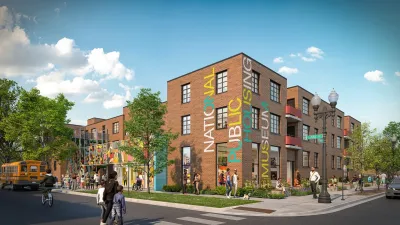From education to housing to health, Chicago's Gary Comer, billionaire founder of Lands' End, invested millions into the struggling South Side neighborhood of Pocket Town in a mission to transform it into a beacon of hope for the community.
Although it was never Gary Comer's intention to see the fruits of his labor in his lifetime, from one venture to the next, he's invested $86 million into projects aiming to improve Pocket Town, the neighborhood where he grew up in Chicago's South Side. Starting with a $68,000 check to fix an electrical problem at "the two-story red brick Paul Revere Elementary School," to investing $12 million in an affordable housing program, to setting up the Comer Science and Education Foundation, Comer made sure “he would take care of [the] neighborhood” long after his passing in 2006.
Elly Fishman writes, “Comer’s hugely ambitious quest contains elements of both the Kalamazoo Promise (a Michigan philanthropist’s pledge to pay for college for all local kids who graduate from public high school) and the Harlem Children’s Zone (an urban renewal program that provides an assortment of “cradle-to-career” services for children and families in New York City’s Harlem neighborhood). The plan he eventually hit upon was to address the interconnected problems facing Pocket Town’s residents: poorly performing schools as well as issues like substandard housing and inadequate health care.”
With all that said, Fishman asks, “What results has that huge investment yielded? And what lessons are there for policymakers, philanthropists, and everyone who cares about the fate of struggling urban neighborhoods?” Comer's initiatives have yielded successes, as well as failures. His health initiatives, for example, led to the vaccination of over 700 children this year. A youth center provides recreational activities, year-round jobs and 6,000 pounds of vegetables annually via a community garden. His housing and education activities have had mixed results.
"On paper," concludes Fishman, "$86 million looks like a helluva lot of money. 'But it’s really hard to change people and communities,” says [Harvard sociologist Robert Sampson]. “We need to be realistic. . . . The social forces that permeate the South Side don’t stop at the Pocket Town boundaries.”
FULL STORY: Can $86 Million Save a Neighborhood?

Alabama: Trump Terminates Settlements for Black Communities Harmed By Raw Sewage
Trump deemed the landmark civil rights agreement “illegal DEI and environmental justice policy.”

Study: Maui’s Plan to Convert Vacation Rentals to Long-Term Housing Could Cause Nearly $1 Billion Economic Loss
The plan would reduce visitor accommodation by 25% resulting in 1,900 jobs lost.

Why Should We Subsidize Public Transportation?
Many public transit agencies face financial stress due to rising costs, declining fare revenue, and declining subsidies. Transit advocates must provide a strong business case for increasing public transit funding.

Paris Bike Boom Leads to Steep Drop in Air Pollution
The French city’s air quality has improved dramatically in the past 20 years, coinciding with a growth in cycling.

Why Housing Costs More to Build in California Than in Texas
Hard costs like labor and materials combined with ‘soft’ costs such as permitting make building in the San Francisco Bay Area almost three times as costly as in Texas cities.

San Diego County Sees a Rise in Urban Coyotes
San Diego County experiences a rise in urban coyotes, as sightings become prevalent throughout its urban neighbourhoods and surrounding areas.
Urban Design for Planners 1: Software Tools
This six-course series explores essential urban design concepts using open source software and equips planners with the tools they need to participate fully in the urban design process.
Planning for Universal Design
Learn the tools for implementing Universal Design in planning regulations.
Smith Gee Studio
Alamo Area Metropolitan Planning Organization
City of Santa Clarita
Institute for Housing and Urban Development Studies (IHS)
City of Grandview
Harvard GSD Executive Education
Toledo-Lucas County Plan Commissions
Salt Lake City
NYU Wagner Graduate School of Public Service





























